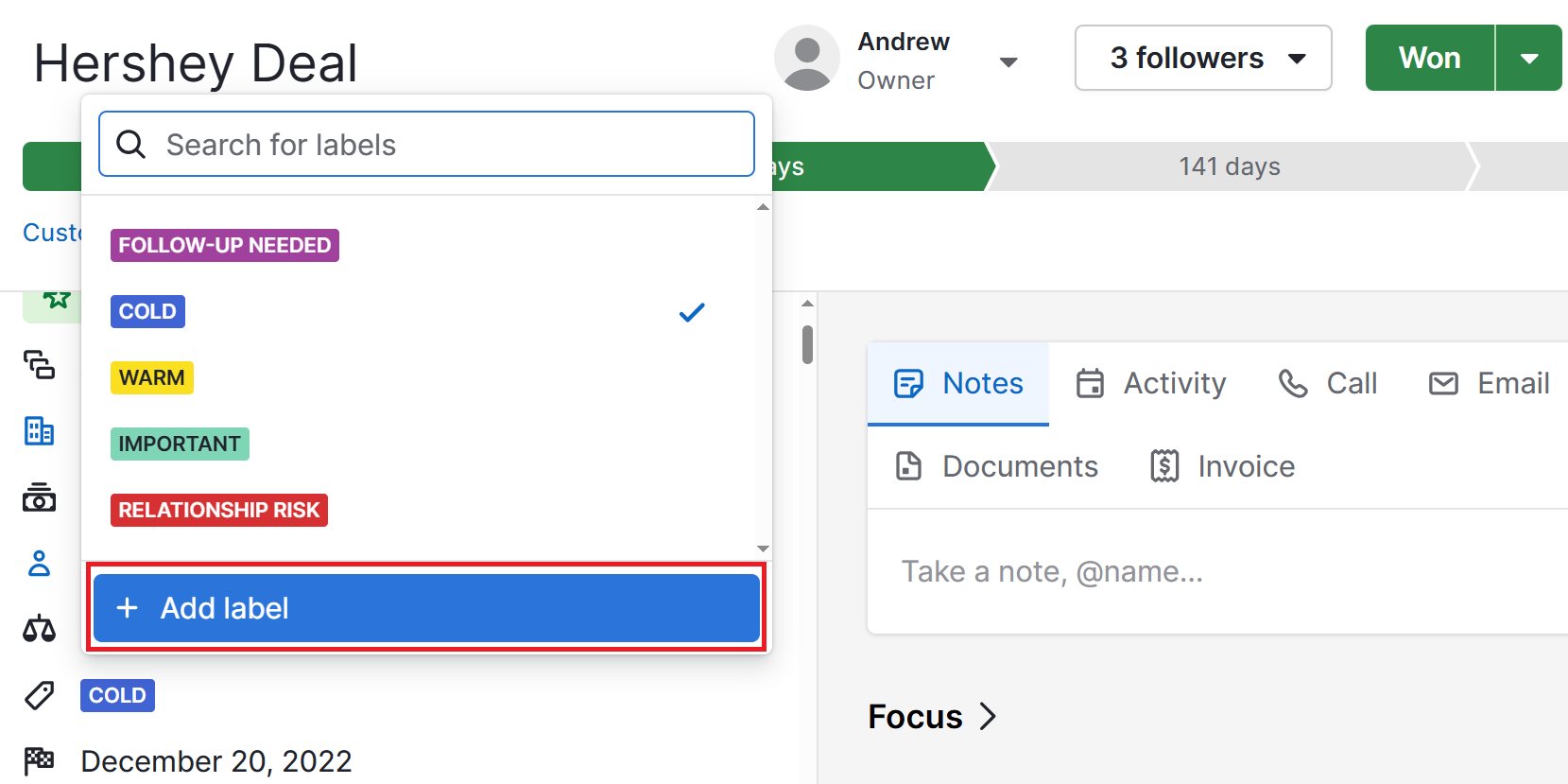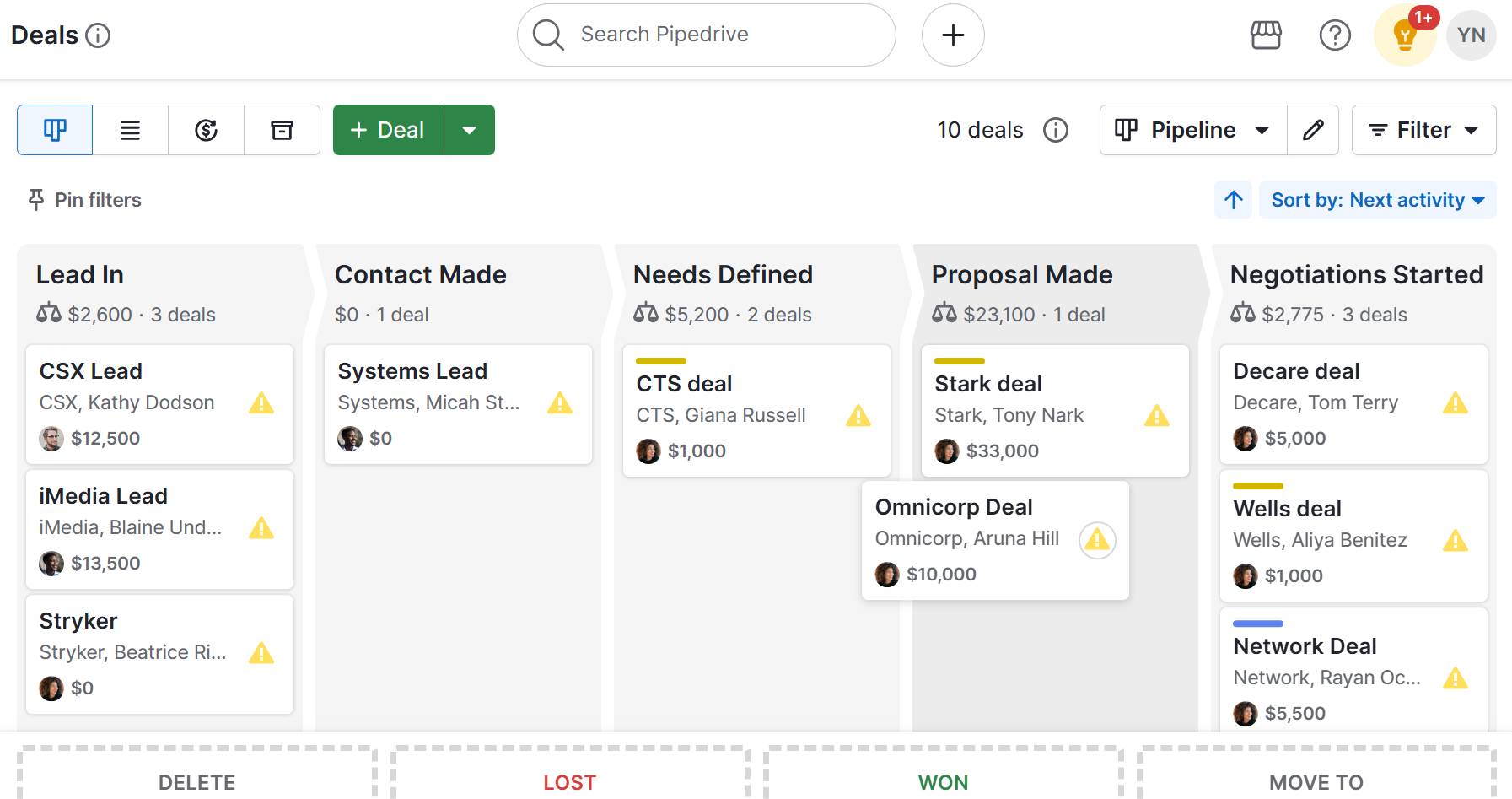While big marketing budgets buy attention, lower budgets rely on resourcefulness.
Guerrilla marketing helps small businesses compete against larger brands without matching their advertising budgets.
By using creative, unconventional tactics in the right places, your SMB can generate memorable brand awareness and qualified leads at a fraction of traditional marketing costs.
In this article, you’ll learn what guerrilla marketing is, five proven tactics for small teams and what to watch out for so your campaigns don’t backfire.
Key takeaways from guerrilla marketing
Guerrilla marketing uses creative, unconventional tactics to capture attention and generate qualified leads without a big budget.
Start with tactics that match your team’s resources and scale up as you learn what resonates with your audience.
Plan for legal requirements, safety and logistics to prevent surprises that could harm your brand or campaign.
Capture and track leads from each campaign in a CRM like Pipedrive to see which tactics turn into revenue – try it free for 14 days
What is guerrilla marketing and why is it important for SMBs?
Guerrilla marketing definition: Unconventional marketing techniques that generate attention through creativity and surprise.
Think eye-catching stunts, interactive experiences or installations in public spaces.
While traditional marketing relies on buying attention through media placements, guerrilla marketing earns attention through memorable experiences that spread through word-of-mouth.
Note: Marketing strategist Jay Conrad Levinson coined the term “guerrilla marketing” in 1984. He drew inspiration from guerrilla warfare tactics, where small forces use creativity to compete with larger opponents.
Guerrilla marketing campaigns deliver specific benefits for SMBs:
They’re cost-effective. Most guerrilla marketing ideas work effectively with small budgets.
They build brand awareness. Creative or interactive experiences stick in prospects’ minds longer than yet another LinkedIn ad.
They encourage social media shares. Surprising guerrilla marketing campaigns get photographed and shared more than run-of-the-mill digital marketing methods.
The catch is that guerrilla marketing examples don’t always translate to SMB reality.
Big companies have legal teams to secure permits, creative agencies to design installations and crisis managers to handle backlash. SMBs need marketing techniques that limited teams can execute without specialized expertise, complex legalities or huge marketing budgets.
Download Your Sales and Marketing Strategy Guide
5 guerrilla marketing tactics that work for small businesses
The best guerrilla campaigns start with one question: what can we do that our competitors won’t?
The marketing tactics below range from simple to complex. Start with ones that match your current SMB resources, then scale up as you learn what resonates with your target audience.
1. Gamification and city hunts
Gamification uses play, like scavenger hunts or competitions, to turn your marketing efforts into an interactive experience.
Gamification creates a memorable experience that people actively choose to join. Unlike traditional advertising that interrupts, city hunts invite participation.
Players spend a couple of hours thinking about your brand while having fun.
Real-life example: Wedding website The Knot celebrated Taylor Swift and Travis Kelce’s engagement by hiding 13 ring boxes across New York City.
.

Fans tracked down the boxes by following Taylor Swift-themed clues posted on The Knot’s Instagram. Each box contained a prize ranging from a gift card to a real diamond ring.
Here are some tips for your SMB’s game or city hunt:
Keep games short and focused. One to two hours is long enough to feel like an experience, but not so long that people lose interest.
Offer instant rewards. To keep the momentum going, give discounts or freebies along the way – not just a final prize.
Build in social moments. Ask players to post a photo, tag friends or share progress online to unlock the next step.
Partner with local businesses to host parts of the game. Whoever you team up with will receive foot traffic while you gain access to their customer base.
Set up a lead capture form for people to register for your game. If you use a customer relationship management (CRM) tool like Pipedrive, tag participants by adding a custom label like “City Hunt October 2025”.

Labeling participants lets you track which guerrilla marketing strategies generate the most valuable leads over time.
2. Pop-up experiences and installations
Pop-ups are temporary brand experiences you set up in high-traffic places like markets or shopping streets.
Installations go a step further. Think large, eye-catching set pieces designed to surprise passers-by and draw them in for a closer look.
Their short lifespan creates urgency while allowing people to connect with your brand face-to-face.
Both formats generate social buzz. People love photographing and sharing something they don’t see every day.
Real-life example: To launch its new cereal-inspired flavors, Ben and Jerry’s set up a giant cereal-bowl-shaped ball pit inside New York’s Grand Central Terminal.
.

Commuters could jump in, snap photos and sample the new ice cream.
Here are some tips for your own SMB pop-up or installation:
Create a clear, interactive focal point. Experiential marketing with something people can touch, try or take a photo with draws attention and encourages sharing.
Tie the experience to your brand. Every element, from signage to giveaways, should communicate what you offer or the problem you solve.
Plan for easy setup and teardown. Pop-ups should be quick to assemble and remove so they don’t disrupt your schedule or incur extra costs.
Invite influencers to your pop-up or installation. Influencer marketing extends your pop-up’s reach beyond foot traffic, helping you get more value from your investment.
3. Strategic stickers and street art
Stickers and street art act like mini-billboards for your brand.
This form of outdoor guerrilla marketing works best when you use clever messaging in unexpected locations.
Generic flyers are easy to ignore, but someone grabbing a snack from a vending machine will likely notice a witty sticker for a healthy meal service.
Real-life example: The Big Issue Group provides sales employment opportunities for people experiencing homelessness. In 2023, the UK charity behind the eponymous magazine transformed a building exterior into a shopfront.
.

The idea was to challenge perceptions of its magazine vendors by showing them as entrepreneurs running their own businesses.
Here are some tips for your own stickers or street art:
Match your environment. Unlike obvious advertising, stickers or visuals should feel natural where people discover them.
Use durable, removable materials. Weather-resistant, non-permanent designs reduce damage and legal risk.
Choose audience hotspots. Target locations where your ideal customers spend time, like co-working spaces, campuses or hotels.
Use social media marketing to help spread the word. Share photos of your art with a unique hashtag to encourage others to post when they spot your designs.
4. Surprise service delivery
Surprise service delivery means offering your service in unexpected locations or ways.
A mobile phone repair service might offer free screen protector installation at a festival. A health startup might offer free posture checks outside coworking spaces.
This form of marketing lets people experience your value firsthand and makes it more memorable.
Real-life example: Research charity the British Heart Foundation put a second-hand sofa in the long queue for the Wimbledon tennis tournament.
.

The unexpected comfort brought awareness to the charity’s e-commerce store and nationwide furniture delivery service.
Here are some tips for your surprise service:
Find high-need locations. Think about where your target customers might experience a problem you can offer an immediate fix for.
Keep logistics simple. Choose services you can deliver with minimal setup and staff so the surprise feels spontaneous, not staged.
Make the connection clear. Include a simple sign or short explanation linking the surprise service to your business, so people remember who helped them once the moment’s over.
Remember that the best surprise services feel like a helpful gesture rather than a sales pitch.
5. Flash mobs and street performances
Public performances rely on surprise and spectacle. Two things that always draw a crowd.
These could be dances, freeze scenes, musical acts or any kind of performance that makes people stop and pay attention.
Real-life example: UK restaurant chain Pizza Express brought together over 50 pizza chefs for a synchronized dough-tossing performance
.

The performance, which marked the opening of a new restaurant, took place in one of London’s busiest areas.
Here are some tips for flash mob or performance efforts by your SMB:
Keep performances short. Observational research shows most bystanders don’t stay beyond a few songs for street performances, so stick to 3–5 minutes to maintain energy and surprise.
Scout locations for your target audience. Pick areas where your ideal customers already gather and can safely stop to watch.
Plan a natural brand reveal. Let the performance be entertaining on its own before showing any branding.
Film your performance to get the most out of it. You can post the whole video online, create shorter clips for social media and write a blog post about it on your site.
What SMBs need to watch out for with guerrilla marketing
Guerrilla marketing carries risks, from mismanaged logistics to misjudged public reactions..
Planning for problems helps prevent them and protects your marketing efforts. Here are a few things to watch out for.
Legal and compliance considerations
Many guerrilla marketing tactics take place in public spaces. To avoid running into trouble, you need to know what’s allowed before you start:
Most cities require permits for pop-ups, live events or branded displays in parks or streets. Placing stickers or posters can count as advertising and require permission.
Always get permission before using public or private property. Even creative tactics like street art or stickers need approval from property owners or local authorities.
If you plan to film or photograph people, check privacy laws. You can’t use identifiable faces in marketing without written consent in some places.
The safest option is to get written approval from the local authority or property owner. It protects you from fines and helps your campaign run smoothly.
Brand and reputation risks
Guerrilla marketing relies on an element of surprise and grabbing attention, but a misstep can spark backlash and harm your brand’s credibility.
Real-life example: Airbnb launched a campaign offering a sleepover experience in a tower on the Great Wall of China.
.

While the idea drew global attention, Airbnb later canceled the event after backlash from Chinese authorities and conservationists, citing concerns over heritage protection.
As part of your guerrilla marketing plan, ask:
Could this stunt make someone feel tricked, embarrassed or unsafe?
Would the SMB still be proud of this tactic if it went viral for the wrong reasons?
Consider whether your campaign idea aligns with your brand values and how your audience might feel about it.
Resource and execution challenges
For small teams, the planning that goes into pulling off guerrilla marketing can stretch capacity.
Start with campaigns that one or two people can manage from start to finish. Treat them like any other project, plan tasks in advance and set clear deadlines.
Here are some ways to stay efficient:
Decide who’s responsible for creative, legal requirements and setup so nothing falls through the cracks.
Create and test materials (like stickers or signage) in advance.
Team up with local partners to split tasks and share costs.
A small, well-run campaign builds momentum and confidence. Once you prove the process works, you can expand by trying the same tactic in a higher-footfall area or testing other guerrilla approaches to compare their performance.
Measurement and ROI difficulties
Guerrilla marketing happens mostly offline, making tracking harder than digital campaigns.
That’s why it’s essential to plan early for how you’ll capture leads or customer engagement signals.
Think about where it makes sense to include QR codes or sign-up forms where you can capture customer data. Even partial information helps you judge which ideas are worth repeating.
Once you capture this data, you can enter it into a CRM system like Pipedrive so you don’t lose track of real-world leads.

Assign leads to pipelines created specifically for guerrilla campaigns and set up custom stages that match your unique sales process.
Pipedrive in action: High-end magicians The BlackTies used Pipedrive to manage leads and sales tasks while performing over 250 shows a year.
The CRM helped them track deals, follow up with clients and stay on top of post-sale details. After a year, their revenue increased by 120%.
Scott Zhou, a magician at The BlackTies, says, “The pipelines and deal stages give us clarity in terms of how our potential bookings are going, as well as how our confirmed bookings are going.”
This data capture setup lets you follow each lead’s journey, from first contact through follow-up, deal progress and post-sale actions. All in a clear visual format.
Final thoughts
You don’t need to be Coca-Cola or McDonald’s to pull off guerrilla marketing. This creative advertising strategy allows small businesses to compete without matching bigger marketing budgets.
You build brand awareness and generate qualified leads using creative, low-cost tactics in the right places. The key is connecting each guerrilla campaign to your sales process to track which tactics turn attention into revenue.
Try Pipedrive free for 14 days to capture leads from your guerrilla marketing campaigns, tag them by source and measure which creative tactics drive the most valuable customers.





